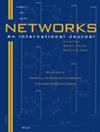Network augmentation for disaster‐resilience against geographically correlated failure
IF 1.3
4区 计算机科学
Q4 COMPUTER SCIENCE, HARDWARE & ARCHITECTURE
引用次数: 0
Abstract
We introduce a formal framework for the study of augmenting networks in the plane for disaster‐resilience, where a disaster is modeled by a straight‐line segment. We generalize various graph structures from classical 2‐edge‐connectivity, including minimal cuts and blocks. The key concept that we introduce is that of an l$$ l $$ ‐leaf, which builds on the fundamental “leaf‐block” concept from classical augmentation. We present a number of algorithms for constructing the above‐mentioned graph structures, including a sweep‐line algorithm that finds all edge‐cuts that can be destroyed by a single disaster. We also present an algorithm which optimally adds a single edge between a pair of l$$ l $$ ‐leaves or blocks while avoiding certain disaster regions. Finally, we present a number of heuristic schemes for solving the disaster‐resilient network augmentation problem and perform extensive experiments to demonstrate the power of the l$$ l $$ ‐leaf concept within heuristic design.针对地理相关故障的灾难恢复能力的网络增强
我们引入了一个正式的框架来研究灾难恢复平面上的扩展网络,其中灾难是由直线段建模的。我们从经典的2边连通性中推广了各种图结构,包括最小切割和块。我们引入的关键概念是l $$ l $$‐叶,它建立在经典增广的基本“叶块”概念之上。我们提出了许多用于构建上述图结构的算法,包括一种扫描线算法,该算法可以找到所有可能被一次灾难破坏的边缘切割。我们还提出了一种算法,该算法在一对l $$ l $$‐叶或块之间最佳地添加一条边,同时避免某些灾难区域。最后,我们提出了一些启发式方案来解决灾难弹性网络增强问题,并进行了广泛的实验来证明l $$ l $$‐leaf概念在启发式设计中的力量。
本文章由计算机程序翻译,如有差异,请以英文原文为准。
求助全文
约1分钟内获得全文
求助全文
来源期刊

Networks
工程技术-计算机:硬件
CiteScore
4.40
自引率
9.50%
发文量
46
审稿时长
12 months
期刊介绍:
Network problems are pervasive in our modern technological society, as witnessed by our reliance on physical networks that provide power, communication, and transportation. As well, a number of processes can be modeled using logical networks, as in the scheduling of interdependent tasks, the dating of archaeological artifacts, or the compilation of subroutines comprising a large computer program. Networks provide a common framework for posing and studying problems that often have wider applicability than their originating context.
The goal of this journal is to provide a central forum for the distribution of timely information about network problems, their design and mathematical analysis, as well as efficient algorithms for carrying out optimization on networks. The nonstandard modeling of diverse processes using networks and network concepts is also of interest. Consequently, the disciplines that are useful in studying networks are varied, including applied mathematics, operations research, computer science, discrete mathematics, and economics.
Networks publishes material on the analytic modeling of problems using networks, the mathematical analysis of network problems, the design of computationally efficient network algorithms, and innovative case studies of successful network applications. We do not typically publish works that fall in the realm of pure graph theory (without significant algorithmic and modeling contributions) or papers that deal with engineering aspects of network design. Since the audience for this journal is then necessarily broad, articles that impact multiple application areas or that creatively use new or existing methodologies are especially appropriate. We seek to publish original, well-written research papers that make a substantive contribution to the knowledge base. In addition, tutorial and survey articles are welcomed. All manuscripts are carefully refereed.
 求助内容:
求助内容: 应助结果提醒方式:
应助结果提醒方式:


